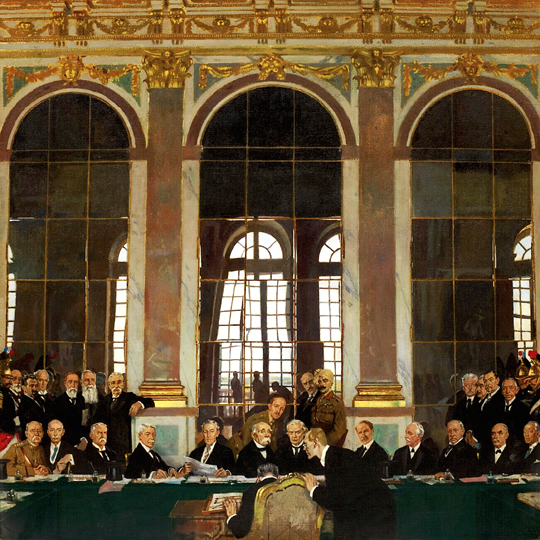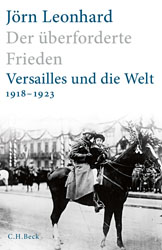Peace Overwhelmed
Freiburg, Oct 12, 2018
Prof. Dr. Jörn Leonhard published "Pandora's Box" four years ago. Since then, it has become a standard work on World War One. In October 2018, the University of Freiburg historian is publishing a monograph that follows on from this book. It is called "Der überforderte Frieden:Versailles und die Welt 1918-1923" ("Peace Overwhelmed: Versailles and the World, 1918-1923"). Nicolas Scherger asked him about his main theories and findings.

Sir William Orpen, the official painter of the British peace delegation in Paris, painted the signing of the peace accord in the Hall of Mirrors at Versailles. The oil painting is located in the Imperial War Museum in London. Source: Wikimedia Commons Public Domain
Mr. Leonhard, how did people a century ago experience the end of World War One?
Jörn Leonhard: The end of the war was a difficult moment. Many soldiers were completely unable to believe that the war was over. Once the weapons were actually silenced, people began to question quickly: "When, precisely, will we be allowed to go home?" Then it became clear that could take some time. French units, for example, were not demobilized because, among other things, an occupation of Germany was expected. In some places, soldiers revolted. The unexpected defeat had left many in Germany deeply shaken because there was a pervasive feeling that four years of sacrifice had been in vain. From this grew the idea that the troops had been undefeated in the field and that socialists and communists on the home front had stabbed the valiantly fighting soldiers in the back. The victorious powers didn't just celebrate either. There was widespread mourning for the many killed.

In his new work, Jörn Leonhard contradicts the classical interpretation that World War One unavoidably led to World War Two: "The people of 1918/1919 also had a future that was burdened in many ways, but it was open in principle and could be shaped." Photo: Thomas Kunz
World War One was, among other things, characterized by industrialization of war. Did people consider that even then?
Yes, and not just among the elites. During that last two years of the war above all, people came to understand that the war was swallowing up more and more industrial resources which were scarce elsewhere. This was especially true of the Central Powers, in whose societies food supplies were permanently dwindling. In all societies, debate was coming to a head about the questions: Who was shirking their duties? And, who was profiting from the war? Social tensions continued to rise, so the state had to approach labor unions, for example, because workers were indispensible for the continuation of the war, regardless of whether they were soldiers or employed in vital industries. After the war's end, there was an enormous challenge to return wartime production to a peaceful economy that made consumer goods. The question of financing was also important. In Germany, the war was for the most part paid for by increasing the supplies of money. This contributed to inflation after the war.
So there were enormous debt burdens and on top of that, the end of the war was not synonymous with an end to violence.
We tend to say that the war ended on 11 November 1918. But that's only true for Western Europe. When you consider Eastern Europe and Russia, a change in the character of the war had actually already begun in 1917. On the territory of the former empire of the tsars, more people died in the Russian civil war that took place from the Bolshevik's October Revolution at the end of 1917 until the end of 1922, than had died in World War One before that. Between 1918 and 1923 there were more than forty small wars that were described by then British cabinet member Winston Churchill as "pygmy wars." This was extraordinarily significant for post-war societies in the fallen tsarist empire, the former Habsburg monarchy, and in the Near and Middle East.

The cemetery and ossuary at Douaumont, near Verdun, France. World War One cost millions of lives. At the end of the war, people had high expectations that the dividends of peace would justify these losses. Photo: Jean-Pol Grandmont, Wikimedia Commons, CC BY-SA 3.0
In many countries, at the start of the war in 1914 the fight was nationally popular and many believed victory come quickly. Yet after four years during which millions sacrificed their lives, concluding a peace awakened major and ultimately unachievable hopes. Did the people live through a decade of unfulfilled expectations?
That is a fundamental aspect and it's why I've called my book the "Der überforderte Frieden" ("Peace Overwhelmed"). Total war went hand-in-hand with the expectation that the dividends of the peace would justify all the sacrifices. That led to an extreme unwillingness to compromise in nearly all societies. In most of the post-war socieites, universal suffrage was also introduced at the end of World War One. The politicians who were negotiating in Paris had to return to face elections at home. Their campaigns set expectations high. Add to that the burden of many debts. In order to gain new allies, promises were made that victory would be followed by territorial gains and influence – for example in the cases of Italy, Romania, and Greece, and to the Arabs as well. As a result, the peacemakers in Paris were confronted with an abundance of hopes, predictions, and visions – all of which peace should bring – including and up to the expectation of a global architecture of peace that would prevent the inferno of 1914 from ever repeating itself.
A peace overwhelmed together with an extension of voting rights to an enormous mass of people whose hopes had been dashed – did that mark the way to radicalization?
We tend to accept this classic interpretation particularly in Germany. My book sets a different tone. You cannot deduce from 1918/1919 as a point in time that the paving stones were already laid for the road to Italian facism, the Nazi regime in Germany, or World War Two. In their letters from the front at the end of the war, many soldiers write that after this war, there can be no others. The hope of the contemporaries of 1918 cannot be stripped from the people by conceiving of history starting from its outcome. The concept of the future that has passed must be used to counter this determinist approach to history. The people of 1918/1919 also had a future. It was burdened in many ways, but it was open in principle and could be shaped. It was clear to many diplomats in Paris, that the peace accord was anything but perfect. But it did achieve stabilization and produced new instruments, such as the League of Nations, which concerned itself for example, with minimum social welfare requirements and the future of former colonies as well as peace. According to the hope of the people of 1918/1919, the peace accord would mark the start of a long peace process.

The compound of the Palace of Nations in Geneva, Switzerland, was the headquarters of the League of Nations, a new international political instrument dedicated to issues such as collective security, conflict resolution, international social security standards, and the future of former colonies. Photo: andi475, Wikimedia Commons, CC BY-SA 3.0
Was World War One a catalyst for modernization as well?
This context is definitely there, but you need to look at it closely. The universal suffrage that was introduced in many places in 1918 was not the result of a civil and human rights movment, but a consequence of the millions of victims of the war. Military service and political participation were newly defined by one another through the experience of the world war. Progressive elements also introduced new ideas about multilateralism and collective security. The mandate system was the first step towards the internationalization of colonial regimes. Along with this comes an awareness that individual countries alone could not effectively address the situation of millions of refugees after World War One. For the Leauge of Nations, Fritjof Nansen tried to resolve this by developing a passport for stateless people that bore his name. Employers officially recognized German trade unions in 1918. They compromised with workers to prevent a socialization of key industries. The social and welfare state received important stimuli because countries had to care for the veterans, widows, orphans, and the wounded. The solutions that were found weren't perfect, but they were approaches that pointed the way.
You've been researching this period for some time. Which findings have impressed you most?
What impressed and at the same time frightened me was how all the plans and scenarios that had been drafted down to the last detail before 1914 were shreddeed within the shortest period of time. The dynamic of violence directed abroad and inwardly tore them asunder on the military fronts as well as at home. The 19th century was dominated by striving for parliaments, constitutions, and regulated political participation within the framework of secured rights. World War One demonstrates how most of these achievements were rolled back within no time at all and how revolutionary situations develop out of new political and social tensions. This is true for more than Russia in 1917. Civil rights that had been adopted in Germany, France, Italy, or Britain were suspended. You get a feeling for how thin the varnish was. In the same way, up to 1923, you can exemplarily follow the significance of the ethnicization of politics, the tightening of criteria for belonging, and the increase in ethnic violence. In "Pandora's Box" I wrote somewhat polemically that the winner of the war was war itself. At the same time, that is the biggest disappointment – that war as an option, both internationally and domestically, as international and civil war, still wasn't ruled out but remained a means to pursue claims to power or violently revise the peace accords of 1919/1920.

To read more
Leonhard, Jörn: Der überforderte Frieden: Versailles und die Welt 1918-1923. München 2018.
Leonhard, Jörn: Pandora's Box: A History of the First World War. April 2018.
Leonhard, Jörn: Die Büchse der Pandora. Geschichte des Ersten Weltkriegs. 5th Edition, Munich 2014; Paperback edition 2018.
Source: C.H. Beck

